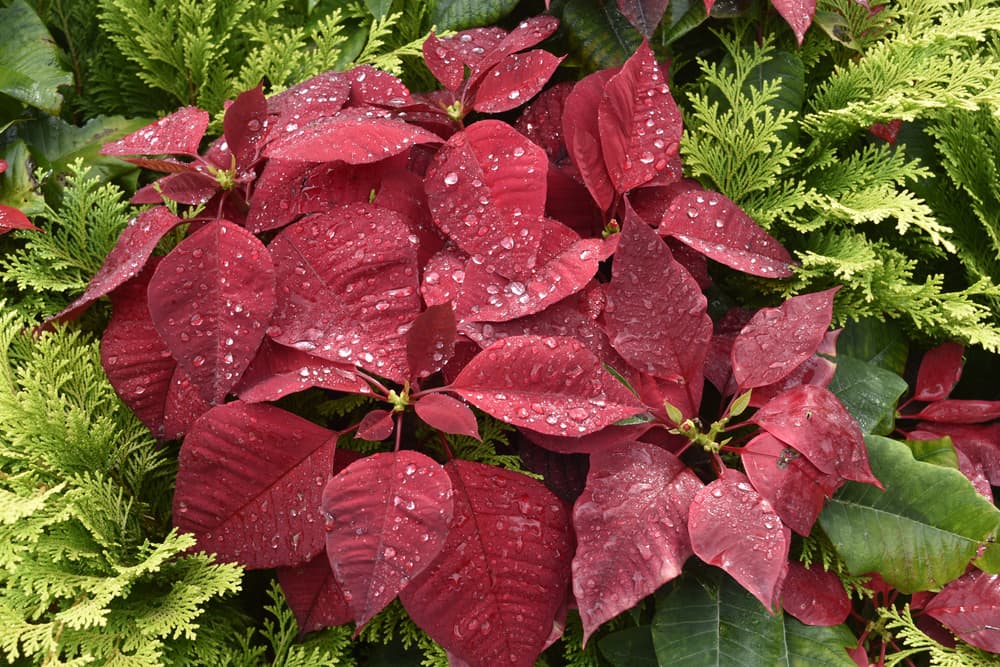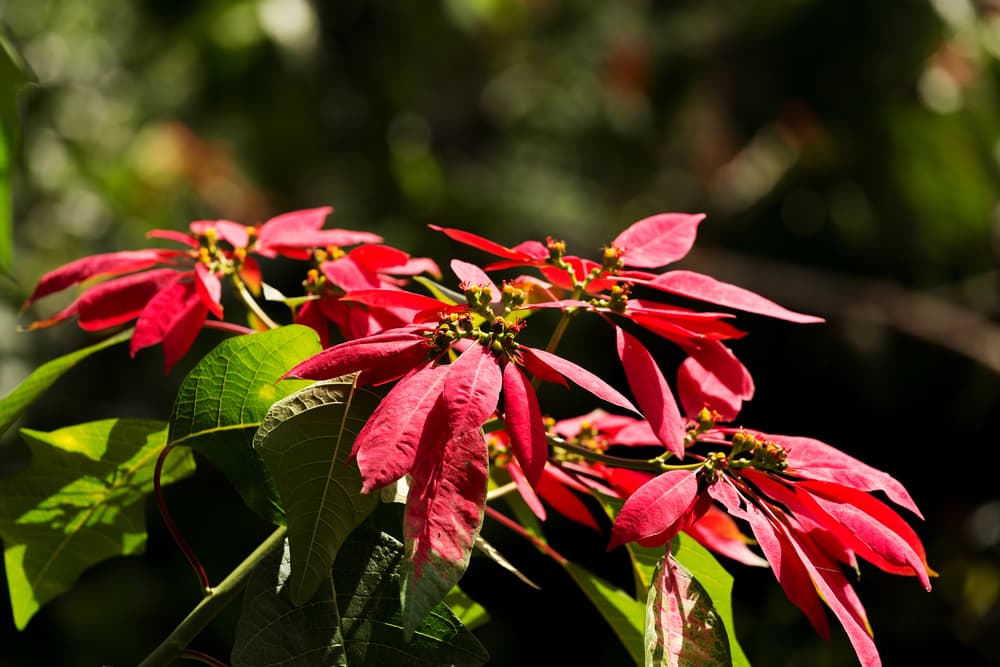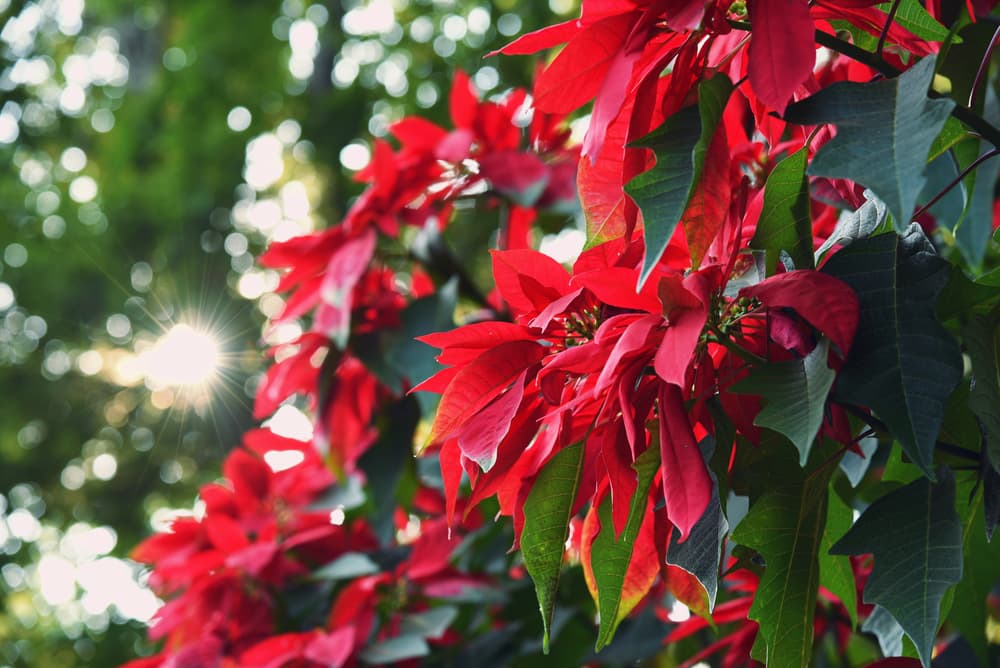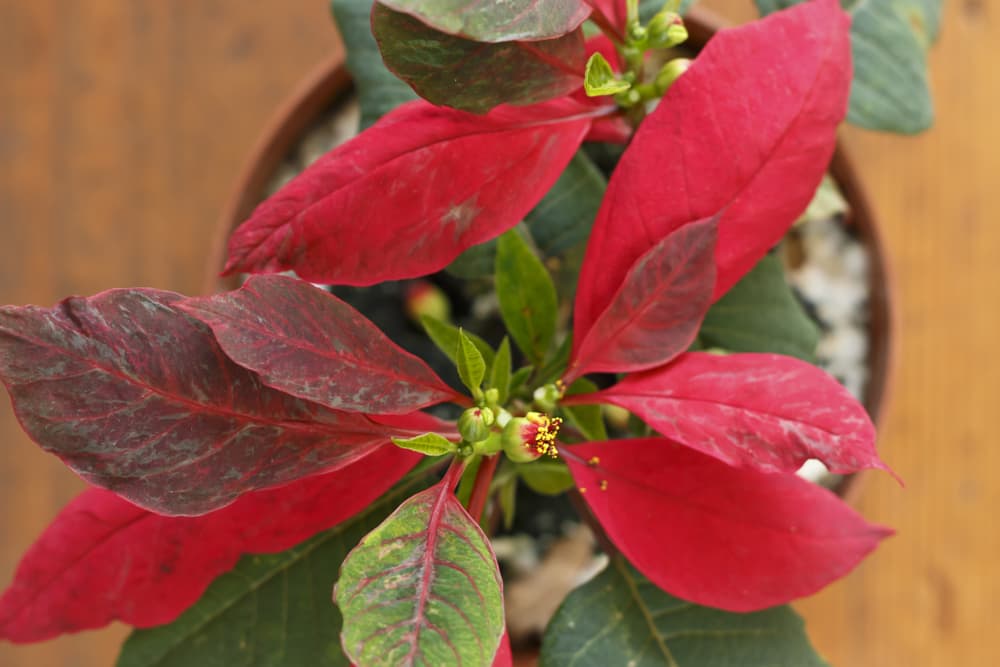HOUSEPLANTS > POINSETTIA
Reviewed By COLIN SKELLY

Colin is a Horticulturist and Horticultural Consultant with experience in a range of practical and managerial roles across heritage, commercial and public horticulture. He holds the Royal Horticultural Society’s Master of Horticulture award and has a particular interest in horticultural ecology and naturalistic planting for habitat and climate resilience.
IN THIS GUIDE
POINSETTIA GUIDES
When you think of poinsettias, you almost certainly think of Christmas.
With their star-like leaves and (most commonly) red and green colour, these vibrant flowering plants make a popular addition to many UK homes over the festive season.
Yet to bring it into your home during its December flowering period, only to discard it weeks later, does the poinsettia an injustice.
In fact, if properly cared for, this colourful plant can survive the rest of the year in the UK, ready to bloom again next Christmas.

As the poinsettia is native to Mexico, it does require some care and attention to keep it alive this far north – this is not a plant you can leave to fend for itself.1Fishburn, J. (2020, December 14). History of Poinsettia. College of Agricultural, Consumer & Environmental Sciences: Illinois Extension. Retrieved March 22, 2023, from https://extension.illinois.edu/blogs/prairies-perennials/2020-12-14-history-poinsettia
We’ve put together this guide to the best poinsettia care and growing tips, to show you how you can keep a poinsettia healthy throughout the year, and benefit from its beautiful display of festive flowers for a second season – because a poinsettia isn’t just for Christmas!
Overview
| Botanical Name | Euphorbia pulcherrima |
| Common Name(s) | Poinsettia |
| Plant Type | Houseplant |
| Native Area | Mexico and Central America |
| Hardiness Rating | H1-H2 |
| Foliage | Evergreen houseplant |
| Flowers | Grown for bright red bracts |
| When To Sow | May |
| Flowering Months | January, December |
Sunlight
Preferred
Bright Filtered Light
Exposure
Sheltered
Size
Height
0 – 60cm
Spread
0.1 – 0.5M
Bloom Time
December – January
Soil
Preferred
Free Draining Medium
Moisture
Well drained
pH
Any
The poinsettia (Euphorbia pulcherrima) is a perennial shrub, native to the sub-tropical forests of Mexico and Central America.
The plant gets its name from Joel Roberts Poinsett, a US diplomat based in Mexico, who was the first person to bring it to the US in 1828 – from where it was cultivated and sold around the world.2A Publication of the International Society For Horticultural Science. (2011). Chronica Horticulturae. Retrieved March 22, 2023, from https://www.actahort.org/chronica/pdf/ch5103.pdf
National Poinsettia Day is celebrated on 12th December, to commemorate the anniversary of his death.3Poinsett’s Popular Poinsettia. (2013, December 12). US House of Representatives: History, Art & Archives. Retrieved March 22, 2023, from https://history.house.gov/Blog/2013/December/12-12-Poinsett/
Other names for poinsettia include Mexican Flame Leaf, Winter Rose and Noche Buena, as well as the more festive Christmas Flower and Christmas Star.

The poinsettia is a hugely popular plant for the festive season, and many households will purchase one to display as a decoration in December, and then discard it come January.
Potted poinsettias typically reach a height of up to 60cm and a spread of up to 40cm.
As well as the most popular flaming red colour, poinsettia bracts (as the colourful leaves are more accurately known) can be orangey, yellow, pink or white.
Hybrids with bi-coloured and marbled leaves are also available – in fact, there are now over 100 different varieties of named poinsettias.4Poinsettia Facts – The Poinsettia Pages. (n.d.). University of Illinois Extension. Retrieved March 22, 2023, from https://web.extension.illinois.edu/poinsettia/facts.cfm

The coloured bracts surround the true flower of the plant, which are the yellow and green clusters at the centre.
As the bracts are leaves, not petals, they last much longer than regular flowers (up to 12 weeks), which is what enables people to display them in their homes for such a lengthy amount of time over the festive period.
Plant Care
Sunlight
Poinsettias require bright, filtered light in order to thrive.
Their ideal growing temperature is 15–20°C, although they can go down to 13°C around pruning time (April).

The best place to put them is on a windowsill or in a greenhouse, where they can bask in non-direct sunlight.
You can also place them outside in a sheltered area of the garden, during summertime only.
Watering
Poinsettias require sufficient water, but not too much.
You should aim to water the plant only when the top layer of its soil is almost completely dry.
Be very careful not to over-water your poinsettia, as this can lead to root rot and can kill the plant.
Poinsettias flower in humid conditions, so you can mist your plant during winter to replicate this.

Habitat & Growing Conditions
The native habitat of poinsettias is in the sub-tropical forests of Mexico, where they grow on hillsides and wooded ravines, and thrive in semi-cool, humid conditions, with lots of sunlight.
Their flowering period is during winter, December to January, during which time they experience short days of 10-12 hours.
The ideal growing temperature for poinsettias is between 15-20°C.

They grow in loose soil with good drainage – they like it to be moist, but not waterlogged, as this can cause root rot.
In warm, tropical climates, poinsettia shrubs growing outside can reach heights of up to 3m – much larger than the potted versions grown in the UK.
Buying Poinsettia
The best place to buy a poinsettia is from a reputable garden centre, where it will (hopefully) have been taken care of in the proper way i.e. kept warm and given the correct amount of water.
Poinsettias are also available to purchase from many supermarkets and shops around Christmas time.
However, they will often have been treated in the same way as the rest of the flowers on sale, and may have been under or overwatered, and placed in a draughty area near the door, which is too cold for the plant to remain healthy.

We’d advise you never buy a poinsettia from an outdoor market, for the same reason.
You should always check the soil of your poinsettia prior to purchasing – the soil of a well-cared-for plant should be slightly damp, but not too wet.
Once purchased, wrap the plant carefully in paper or a plastic bag when taking it home from the shop during winter, to prevent damage to the leaves from cold temperatures.

A plant which has been grown in the UK will be more hardened to our climate, so try to buy locally if you can.
How To Make Poinsettias Rebloom
In order to make your poinsettia re-bloom the following December, you’ll need to care for it throughout the year and replicate its natural growing conditions.
This includes pruning it in spring and repotting it in early May.
You should then keep your poinsettia in a light place at a temperature of 15-18°C.
Once the new growth has reached 15–20cm, pinch the tips to encourage branching.

The key to making your poinsettia re-bloom is to replicate its short winter days.
Come autumn, start leaving it in the light for 10 hours, then moving it to an entirely dark room, devoid of any natural or artificial light, for the remaining 14 hours.
If you don’t have a suitable room, you could cover the poinsettia with a large box instead.
Ensure the daytime temperature remains constant at around 18-20°C (the nightly temperature can be slightly cooler, around 13-15°C).

Continue to do this every day, without fail, until December, and the bracts should hopefully start to turn colourful again.
Getting a poinsettia to re-bloom is not an easy task, and you shouldn’t be disheartened if it doesn’t happen.
“Commercial growers control the conditions for Poinsettia growth very carefully, closely monitoring temperature, humidity and light exposure to be ready for sale at specific weeks in the year,” says Master Horticulturist Colin Skelly.
“Trying to replicate this at home is not easy, so don’t be disheartened!”
It’s also important to be aware that, even if you do everything right, poinsettias will not be as impressive second time around.
They are likely to be taller and more shrub-like, and their blooms will be vastly inferior compared to the first year’s show.
Two years is the maximum you can reasonably expect to get out of the plant.
Common Problems
Overwatering
Although they favour a humid environment, poinsettias are very sensitive to overwatering.
Excessive water and poor drainage can cause root and stem rot, and kill the plant.
To avoid this problem, make sure to only add water when the surface of the soil has almost – but not completely – dried out.
Mould
Poinsettias are also susceptible to mould and mildew, which can appear as anything from a dusty white covering, to lesions and brown spots on leaves.

Botrytis cinerea (grey mould) is one of the worst culprits.
Mould can be caused by watering the leaves, high humidity, and stagnant air in a greenhouse – fight it by increasing airflow, decreasing humidity and applying a preventative fungicide.
Leaf Dropping
Another common problem that growers face is leaf-dropping.
This can occur as a result of overly warm, dry growing conditions.
If your poinsettia’s leaves are dying, move it to a slightly cooler location, make sure it has enough water and mist it using a spray bottle to replicate humidity.
References
- 1Fishburn, J. (2020, December 14). History of Poinsettia. College of Agricultural, Consumer & Environmental Sciences: Illinois Extension. Retrieved March 22, 2023, from https://extension.illinois.edu/blogs/prairies-perennials/2020-12-14-history-poinsettia
- 2A Publication of the International Society For Horticultural Science. (2011). Chronica Horticulturae. Retrieved March 22, 2023, from https://www.actahort.org/chronica/pdf/ch5103.pdf
- 3Poinsett’s Popular Poinsettia. (2013, December 12). US House of Representatives: History, Art & Archives. Retrieved March 22, 2023, from https://history.house.gov/Blog/2013/December/12-12-Poinsett/
- 4Poinsettia Facts – The Poinsettia Pages. (n.d.). University of Illinois Extension. Retrieved March 22, 2023, from https://web.extension.illinois.edu/poinsettia/facts.cfm


